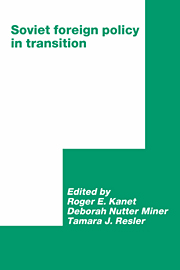Book contents
- Frontmatter
- Contents
- List of tables
- List of contributors
- Preface
- Introduction
- Part I The Soviet Union and the international political system
- Part II The Soviet Union and Europe
- Part III The Soviet Union and the developing world: global trends
- Part IV The Soviet Union and the developing world: regional and country case studies
- 8 Soviet policy in Central America during the Gorbachev period
- 9 The Soviet reassessment of socialist orientation and the African response
- 10 Soviet policy in the Middle East: Gorbachev's imprint
- 11 The implications of perestroika for the Third World, particularly Asia
- 12 The Soviet Union and Indochina
- 13 Gorbachev's Southeast Asia policy: new thinking for a new era?
- 14 The impact of Gorbachev's new thinking on Soviet policy toward South Korea
- Part V Conclusion
- Index
12 - The Soviet Union and Indochina
Published online by Cambridge University Press: 05 February 2012
- Frontmatter
- Contents
- List of tables
- List of contributors
- Preface
- Introduction
- Part I The Soviet Union and the international political system
- Part II The Soviet Union and Europe
- Part III The Soviet Union and the developing world: global trends
- Part IV The Soviet Union and the developing world: regional and country case studies
- 8 Soviet policy in Central America during the Gorbachev period
- 9 The Soviet reassessment of socialist orientation and the African response
- 10 Soviet policy in the Middle East: Gorbachev's imprint
- 11 The implications of perestroika for the Third World, particularly Asia
- 12 The Soviet Union and Indochina
- 13 Gorbachev's Southeast Asia policy: new thinking for a new era?
- 14 The impact of Gorbachev's new thinking on Soviet policy toward South Korea
- Part V Conclusion
- Index
Summary
Political relations between Vietnam and the Soviet Union date back to 30 June 1923, when Ho Chi Minh made the first journey by a Vietnamese revolutionary to Bolshevik Russia. Shortly after his arrival, Ho joined the Communist International (Comintern) and actively worked to establish a firm institutional relationship between the Comintern and Vietnam. In February 1930, Ho, acting on behalf of the Comintern, presided over the founding of the Vietnam Communist Party (VCP). Party-to-party ties were formally established in October 1930 when the VCP, now renamed the Indochinese Communist Party, joined the Comintern.
The Soviet Union granted diplomatic recognition to Ho Chi Minh's fledgling Democratic Republic of Vietnam on 31 January 1950, nearly five years after it was founded. However, it was only after the end of the First Indochina War (1946–54) that formal state-to-state relations were established, when a Soviet embassy was opened in Hanoi. In July 1955 Ho Chi Minh paid his first visit to Moscow as president of the DRV. During the course of this visit, the Soviet Union announced its first grant of large-scale economic assistance. The Soviet Union also contributed heavily to Vietnam's first three-year plan (1958–60) and first five-year plan (1961–65).
On the political front Soviet-Vietnamese relations were not particularly close during the Khrushchev period. This was reversed during the Brezhnev years, partly as a result of Moscow's military and economic aid to Vietnam during the Second Indochina War (1965–75).
- Type
- Chapter
- Information
- Soviet Foreign Policy in Transition , pp. 236 - 255Publisher: Cambridge University PressPrint publication year: 1992



